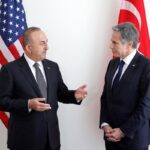
KYIV, Ukraine (AP) — Ukrainian fighters extracted from the last bastion of resistance in Mariupol were taken to a former penal colony in enemy-controlled territory, and a top military official hoped they could be exchanged for Russian prisoners of war. But a Moscow lawmaker said they should be brought to “justice.”
The Russian parliament planned to take up a resolution Wednesday to prevent the exchange of Azov Regiment fighters, who held out for months inside the Azovstal steelworks plant while Mariupol was under siege, according to Russian news agencies.
Nearly 1,000 Ukrainian troops holed up at Azovstal have handed themselves over this week, the Russian Defense Ministry said Wednesday. More than 260 left Monday, and nearly 700 left since then.
Many are wounded, and it’s not clear how many fighters still remain at the sprawling steel mill.
Earlier, Ukraine’s deputy defense minister, Hanna Maliar, said negotiations for the fighters’ release were ongoing, as were plans to take out fighters who are still inside the sprawling steel mill. Ukrainian President Volodymyr Zelenskyy said “the most influential international mediators are involved” in the plans. Officials have not said how many remain inside.
The troops in the waterside steel plant have been the last pocket of resistance in Mariupol, which has been effectively in Russian hands for some time now.
In an unrelated development that could take the sheen off of any Russian declaration of victory in Mariupol, Sweden and Finland both officially applied to join NATO on Wednesday, a move driven by security concerns over the Russian invasion.
Russian President Vladimir Putin launched the invasion on Feb. 24 in what he said was an effort to check NATO’s expansion but has seen that strategy backfire by driving the public in Sweden and Finland, traditionally nonaligned nations, toward the Western alliance.
NATO Secretary-General Jens Stoltenberg said he welcomed the applications, which now have to be weighed by 30 member countries.
Mariupol was targeted by Russia in the early days of the invasion. Britain’s Ministry of Defense said in its daily intelligence report Wednesday that Ukraine had bitterly contested the strategic port city, costing Russia time and troops as it sought to capture a land corridor from its home territory to the Crimean Peninsula, which it seized from Ukraine in 2014.
“Despite Russian forces having encircled Mariupol for over 10 weeks, staunch Ukrainian resistance delayed Russia’s ability to gain full control of the city,” the ministry said. “This frustrated its early attempts to capture a key city and inflicted costly personnel losses amongst Russian forces.”
More than 260 Ukrainian fighters — some of them seriously wounded and taken out on stretchers — left the ruins of the Azovstal plant on Monday and turned themselves over to the Russian side in a deal negotiated by the warring parties. Russian Defense Ministry spokesman Maj. Gen. Igor Konashenkov said Wednesday that 694 Ukrainian soldiers handed themselves over in the past 24 hours, bringing the total to 959.
Seven buses carrying an unknown number of Ukrainian soldiers from the plant were seen arriving at a former penal colony Tuesday in the town of Olenivka, about 88 kilometers (55 miles) north of Mariupol.
While Russia called it a surrender, the Ukrainians avoided that word and instead said the plant’s garrison had successfully completed its mission to tie down Russian forces and was under new orders.
With the fighters’ departures, Mariupol was on the verge of falling under complete Russian control. Its capture would be the biggest city to be taken by Moscow’s forces and would give the Kremlin a badly needed victory, though the landscape has largely been reduced to rubble.
The soldiers who left the plant were searched by Russian troops, loaded onto buses and taken to two towns controlled by Moscow-backed separatists. More than 50 of the fighters were seriously wounded, according to both sides.
It was impossible to confirm the total number of fighters brought to Olenivka or their legal status. While both Mariupol and Olenivka are officially part of Ukraine’s eastern Donetsk region, Olenivka has been controlled by Russia-backed separatists since 2014 and forms part of the unrecognized “Donetsk People’s Republic.” Prior to the rebel takeover, penal colony No. 120 had been a high-security facility designed to hold prisoners sentenced for serious crimes.
Footage shot by The Associated Press showed that the convoy was escorted by military vehicles bearing the pro-Kremlin “Z” sign, as Soviet flags fluttered from poles along the road. About two dozen Ukrainian fighters were seen in one of the buses.
Ukraine’s human rights ombudsman said the Russian military was also holding more than 3,000 civilians from Mariupol at another former penal colony near Olenivka. Ombudsman Lyudmyla Denisova said most civilians are held for a month, but those considered “particularly unreliable,” including former soldiers and police, are held for two months. The detainees include about 30 volunteers who delivered humanitarian supplies to Mariupol while it was under siege, she said.
While Ukraine expressed hope that the fighters would be released, Vyacheslav Volodin, speaker of the lower house of the Russian parliament, said without evidence that there were “war criminals” among the defenders and “we must do everything to bring them to justice.”
Russia’s main federal investigative body said it intends to interrogate the troops to “identify the nationalists” and determine whether they were involved in crimes against civilians. Also, Russia’s top prosecutor asked the country’s Supreme Court to designate Ukraine’s Azov Regiment a terrorist organization. The regiment has links to the far right.
The operation to abandon the steel plant and its labyrinth of tunnels and bunkers signaled the beginning of the end of a nearly three-month siege that turned Mariupol into a worldwide symbol of both defiance and suffering.
The Russian bombardment killed over 20,000 civilians, according to Ukraine, and left the remaining inhabitants — perhaps one-quarter of the southern port city’s prewar population of 430,000 — with little food, water, heat or medicine.
During the siege, Russian forces launched lethal airstrikes on a maternity hospital and a theater where civilians had taken shelter. Close to 600 people may have been killed at the theater.
Gaining full control of Mariupol, in the south of the eastern Donbas region, would be more of a symbolic boost for Russian President Vladimir Putin than a military win, said retired French Vice Adm. Michel Olhagaray, a former head of France’s center for higher military studies.
“Factually, Mariupol had already fallen,” he said.
But because of the Azovstal defenders’ “incredible resistance,” Ukraine can also claim that it came out on top, he said.
“Both sides will be able take pride or boast about a victory — victories of different kinds,” he said.
Already, Ukrainian presidential adviser Mykhailo Podolyak likened the Ukrainian defenders to the vastly outnumbered Spartans who held out against Persian forces in ancient Greece. “83 days of Mariupol defense will go down in history as the Thermopylae of the XXI century,” he tweeted.
___
McQuillan and Yuras Karmanau reported from Lviv, Ukraine. Mstyslav Chernov and Andrea Rosa in Kharkiv, Elena Becatoros in Odesa, Lorne Cook in Brussels and other AP staffers around the world contributed.
___
Follow AP’s coverage of the war in Ukraine: https://apnews.com/hub/russia-ukraine




